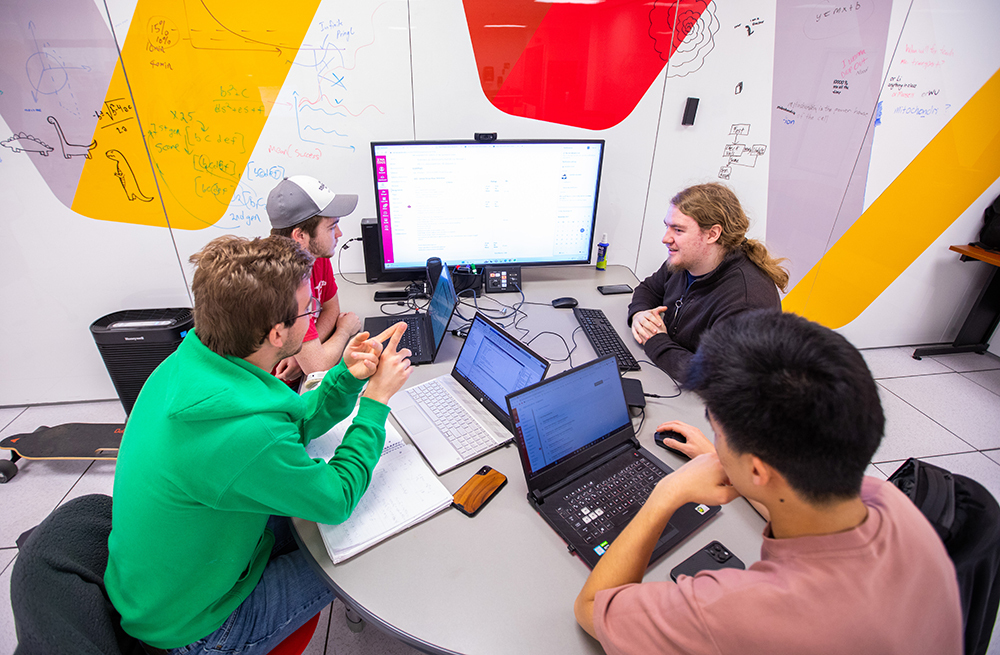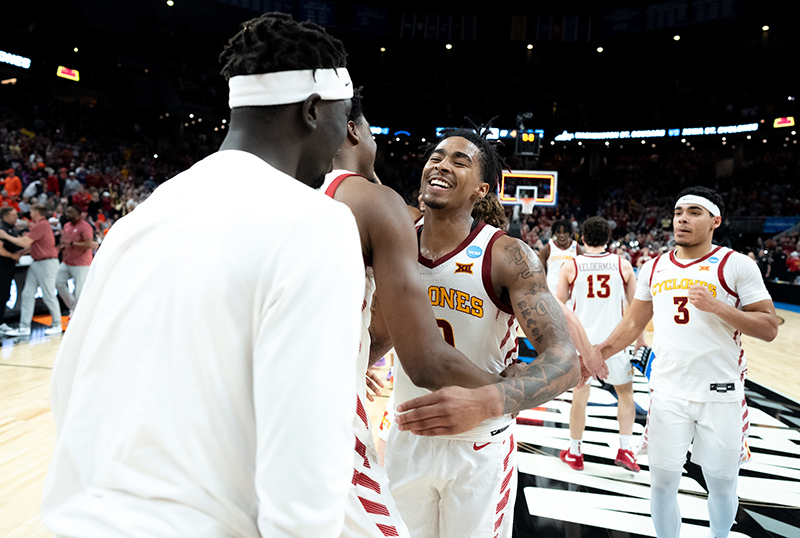Editor's note: This feature is the second in news service's 2024 Innovation at Work series of stories, photos and videos that highlight economic development and the impact of Iowa State's contributions across the state. A new entry will post every Tuesday through April 23.

Mechanical engineering students huddle in "The Mine" in the basement of the Black Engineering Building while working on their capstone project. Counter-clockwise from left are students Nick Felbinger, Jacob Fosse, Wee Sean Koh and Isaac Bibus. Distinguished Professor of Practice Jim Heise teaches the course. Photo by Christopher Gannon.
To get a vintage trolley to stop, an operator grabs the handle of part SA-26, an independent brake valve, and pushes to the right. Compressed air runs through the system and forces brake shoes against the wheels to slow and stop the trolley.
To get going again, the operator, no doubt dressed in throwback hat and uniform, releases the brakes with a pull to the left and a rush of vented air.
That brake valve is an essential part if you want to restore a trolley or build an authentic replica. But what do you do if you're the Gomaco Trolley Co. in Ida Grove, and that valve is no longer on the market?
If you're Lex Jacobson, a 1998 Iowa State mechanical engineering graduate and the manager of the trolley company, you contact Iowa State's capstone course in mechanical engineering. That gets two teams of senior student-engineers doing some reverse-engineering.
Video story
Innovation for Business, featuring the Gomaco Trolley Co.
You'll ask them to take SA-26 apart -- there are 46 diagramed parts and pieces that are no longer protected by patents -- and figure out how the pieces can be manufactured and assembled.
Nine students worked on the problem during a recent class session, one team working on the cast-iron casing, the other working on the pins and springs of the inner workings. It turned out to be more of a challenge than they expected.
The scanning laboratory gave them a good start on producing proper 3D engineering drawings. But it didn't answer all the questions: "What sizes are the parts? What are they made of? What are the angles? What are our manufacturing recommendations?" said Nell Jaskowiak, a student from St. Louis.
Just as important as working out the engineering specifications, said Tyler Hentzel, a student from Ankeny, "is understanding what our sponsor wants."
Making a pitch for student teams
Jim Heise, a Distinguished Professor of Practice and one of the instructors of ME 415, "Mechanical Systems Design," said 214 seniors are working in 38 teams this spring semester. And he would love to have more projects for the students to manage, engineer and design.
Since the class started in 2008, students have completed 354 projects for 144 Iowa manufacturers. The companies pay a sponsorship fee (now $5,000 for Iowa companies and $8,000 for out-of-staters) to support the course and its expenses.
"The beauty of the program is you get two teams of students, with four or five to a team, all focused on one problem," Heise said. "You get two parallel paths of ideas."
But wouldn't assigning the project to an intern be as useful?
Heise shakes his head: "The capstone course gets more students working on a problem than an internship would, at the same cost."
Who could use a capstone team
Mayra Stephanie Ramirez, a workforce engagement specialist who works with capstone courses for Iowa State's Center for Industrial Research and Service (CIRAS), shares a one-pager to help companies identify potential capstone projects. It lists four phrases that could indicate a company's need for one:
- "I wish I had the time to ..."
- "It's not that difficult, it's just not a priority."
- "It's on the back burner."
- "That's on my engineer's 'to-do' list."
Capstone projects are important, Ramirez's document says, because they "can be a hiring conduit for companies to identify potential students for future hiring." And course projects "help create millions of dollars in economic impact and dozens of jobs per year."
Big numbers compiled by CIRAS quantify the breadth, scope and value of Iowa State's capstone courses: Students across the university have completed more than 1,280 capstone projects for more than 440 businesses and delivered an economic impact of more than $447 million.
Engineering for the bottom line
Dave Sly -- a teaching professor in industrial and manufacturing systems engineering who teaches industrial engineering's capstone course, IE 441, "Industrial Engineering Design" -- said his students make about seven trips to the companies they work with.
The students collect data on their field trips. They work with employees. They learn about machines. They observe processes. And they do all they can to find solutions and savings. Those could include improvements to assembly lines, productivity or quality control.
"As industrial engineers, we're very focused on the bottom line, the financial returns," Sly said. "We're not really creating products; we're making products more efficiently."
So much so, the course has a goal of creating $100,000 in net value over three years for each project. The actual returns can be in the millions. Sly said last fall's course included nine projects with a total economic impact of just more than $8 million.
One student team, for example, determined overtime shifts wouldn't be enough to meet production demands for an Ames manufacturer and recommended adding assembly lines instead. The change would ultimately create a gain in net present value of more than $25 million over five years.
That's a big return on investment for the company. There's a big return for the students, too.
When their capstone projects are complete, Sly said, "Our students can engineer, and they can communicate, and they can deliver economic value. Those are important attributes we're producing here at Iowa State."
Putting student projects to work
Lex Jacobson of the Gomaco Trolley Co. had good reasons to turn to Iowa State capstone students for help reverse-engineering the brake valve the company often uses in its manufacturing and restoration work.
First, the students have access to laboratory tools (such as a 3D scanning lab) that the company doesn't have. Second, it can be a great learning exercise for students to take an existing part and figure out how it works and how to build it. And third, the company doesn't always have the time or staff to get to these kinds of projects.
So, Jacobson turned to students. After the two capstone teams working on the brake valve made their midterm presentations, "I thought they were doing well," Jacobson said. "I felt like they had a pretty good approach to the project."
The students said the project has been a learning process. "It's not just cut and paste," said Jonah Magneson, a student from Des Moines. But they're making progress.
That progress is very important to Jacobson and Gomaco: "We're really looking for a solution we can put to work."

